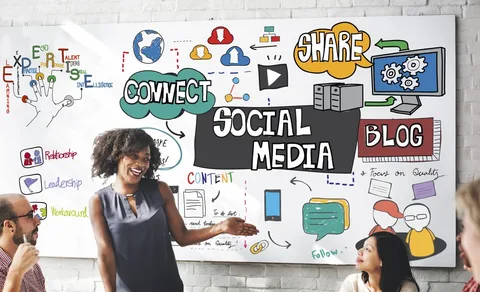
Social media integration in the classroom is changing how students engage and learn in the digital age. Social media has several benefits for education, including new channels for participation, teamwork, and information exchange. It's critical to comprehend social media usage in educational settings as organizations and educators try to capitalize on these advantages. The benefits of social media in education will be discussed in this blog, along with ten useful suggestions for using these tools to improve the educational process.
What is Social Media?
Online tools and platforms that let people create, share, and engage with content are referred to as social media. These platforms comprise, among others, YouTube, LinkedIn, Instagram, Facebook, and Twitter. Social media is an effective tool in the educational environment because it facilitates real-time communication, teamwork, and the sharing of knowledge.
How Social Media Helps Students in Education
For students, social media provides a wealth of advantages. It makes information easier to get, encourages teamwork, and offers a venue for exchanging resources and ideas. Social media use in the classroom can improve communication between teachers and students, increase student participation, and make the classroom more dynamic and engaging. Institutions can assist students in gaining academic success and key skill development by utilizing social media's benefits for education.
10 Tips for Using Social Media in Education

Attract New Students with a Campaign
Using social media to your advantage can help you draw in new pupils. Make focused advertising campaigns that showcase the programs, student accomplishments, and the school's assets. To draw in potential students and their parents, use eye-catching images, encouraging quotes, and success stories. An effective social media campaign may greatly increase the appeal and visibility of your organization.
Build a Community
One of the main benefits of social media in education is the development of a sense of community. On social media sites like Facebook or LinkedIn, create pages or groups where alumni, instructors, and students may interact, exchange stories, and offer support to one another. By encouraging cooperation and peer learning, these virtual communities can improve the quality of education by creating a feeling of community.
Broadcast Updates and Alerts
A great medium for disseminating crucial updates and notifications is social media. Social media gives you the ability to rapidly and efficiently contact your audience with announcements about impending exams, timetable modifications, or emergency alerts. For in-the-moment communication, social media sites like Facebook and Twitter are very helpful in keeping parents and kids updated.
Livestream Your Lectures
Access to education can be increased by livestreaming lectures on websites like Facebook Live and YouTube. Students who are unable to attend classes in person or who are learning remotely would especially benefit from this technique. Another benefit of live-streamed lectures is that they can be recorded, so students can review the information whenever it's convenient for them. This adaptability accommodates different learning velocities and methods.
Focus on Increasing Digital Literacy
One of the most important advantages of social media in school is the rise in digital literacy. Instruct students on responsible and efficient use of social media. This entails being aware of proper internet conduct, identifying reliable sources, and safeguarding personal privacy. By emphasizing digital literacy, you give kids the tools they need to succeed in the classroom and the workplace by helping them navigate the digital landscape.
Generate User-Generated Content (UGC)
Motivate students to produce and distribute learning-related content. Blog entries, movies, and project displays are examples of user-generated content that can improve engagement and offer insightful information about the viewpoints of students. Additionally, UGC encourages students to feel proud of and take ownership of their work, which inspires them to create excellent material.
Create Opportunities for Active and Passive Learning
Both active and passive learning are facilitated by social media. Participating in conversations, exchanging materials, and working together on projects are examples of direct engagement that occurs during active learning. Conversely, passive learning involves ingesting information such as instructional podcasts, articles, and videos. Teachers can design a well-rounded learning experience that accommodates a variety of learning preferences by utilizing both formats.
Teach Networking and Thought Leadership Skills
Students can learn a great deal about professional networking and thought leadership by using social media sites such as LinkedIn. Students should be encouraged to establish an online presence, make connections with professionals in the field, and offer their opinions on pertinent subjects. Gaining these abilities helps students become thought leaders in their professions and prepares them for their future careers.
Develop Discussion and Critical Thinking Skills
Social media can help promote debate and analytical thinking. Establish forums or discussion groups where students can engage in intellectual discourse, exchange ideas, and critical information analysis. These conversations can improve their comprehension of the material as well as their capacity for critical thought and clear communication of ideas.
Celebrate Student and Alumni Achievements
Honoring successes is a wonderful opportunity to show off your students and alumni's accomplishments and to raise spirits. Highlight accomplishments in your job, research contributions, honors, and scholarships on social media. In addition to highlighting individual achievements, these blogs serve as an inspiration to both current and potential students by highlighting the importance of the education you offer.
Conclusion
Social media has several benefits for education, including special chances to improve student participation, teamwork, and academic results. By putting these ten suggestions into practice, educational institutions and instructors can get the most out of social media in the classroom and create a vibrant, dynamic learning environment. Accept the potential of social media to help your pupils learn and get ready for success in the digital age.
Are you ready to integrate social media into your educational strategy? Start today by exploring how these tips can be applied in your classroom or institution. Check our blogs to learn tips for Building a Strong Classroom Community.